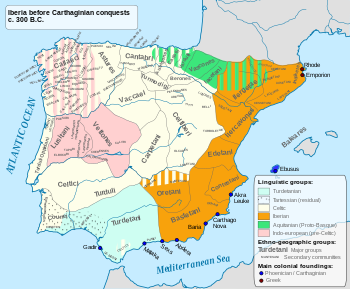
Back Lacetans Catalan Lacetanos Spanish Lazetaniar Basque Lacétans French Lacetanok Hungarian Lacetani IO Lacetani Italian Lacetanos Portuguese

The Lacetani were an ancient Iberian (pre-Roman) people of the Iberian Peninsula (the Roman Hispania). They are believed to have spoken an Iberian language.[citation needed]
The name is mentioned in brief by some Roman period writers. Pliny the elder listed the people in his geographical description of Hispania Citerior, and again as a region of abundant vines, that allow the production of second-rate wine.[1] Martial in an epigram also recalled Laletanian or Lacetanian as a kind of cheap wine.[2] Sallust's Histories has it as a territory that Pompey claimed to have recovered from Sertorius.[3] Mentions by Livy,[4] Plutarch, and Cassius Dio are in the context of the Iberian revolt. However, there remains some doubt whether their naming is not a corruption of either Laietani or Iacetani, the names of two neighboring tribes.[5] Ptolemy located the towns of Aeso/Isona (Guissona) and Setelsis/Selensis (Solsona) among those in a territory, of the Lacetani or the Iacetani.[6]
- ^ Pliny, Natural History, 3.4; 14.8
- ^ Martial, Epigrams, 1.26; 1.49
- ^ Sallust (1965) [1921]. "Letter of Gnaeus Pompeius, Histories 2.4". Sallust: With an English Translation by J. C. Rolfe. Loeb Classical Library (in English and Latin) (revised 1931...reprinted ed.). Harvard University Press. pp. 416–417.
- ^ Livy, Ab urbe condita Libri 21.23, and other sections
- ^
 Smith, William, ed. (1857). "Lacetani". Dictionary of Greek and Roman Geography. Vol. 2. London: John Murray.
Smith, William, ed. (1857). "Lacetani". Dictionary of Greek and Roman Geography. Vol. 2. London: John Murray.
- ^ Ptolemy Geographia 2.6.72, reads Akketanoi or Iaketnnoi, but Stückelberger et al note that the Lacetani are probably meant: Stückelberger, Alfred; Grasshoff, Gerd (2017). Klaudios Ptolemaios, Handbuch der Geographie (in German and Ancient Greek). Vol. 1. Schwabe. p. 197. ISBN 978-3-7965-3703-5.